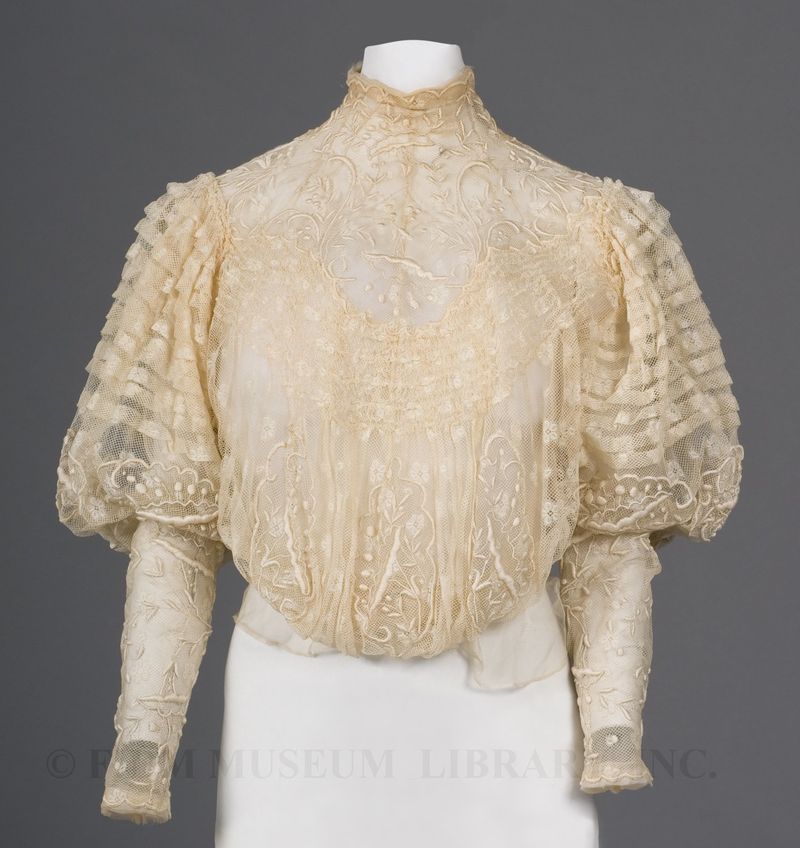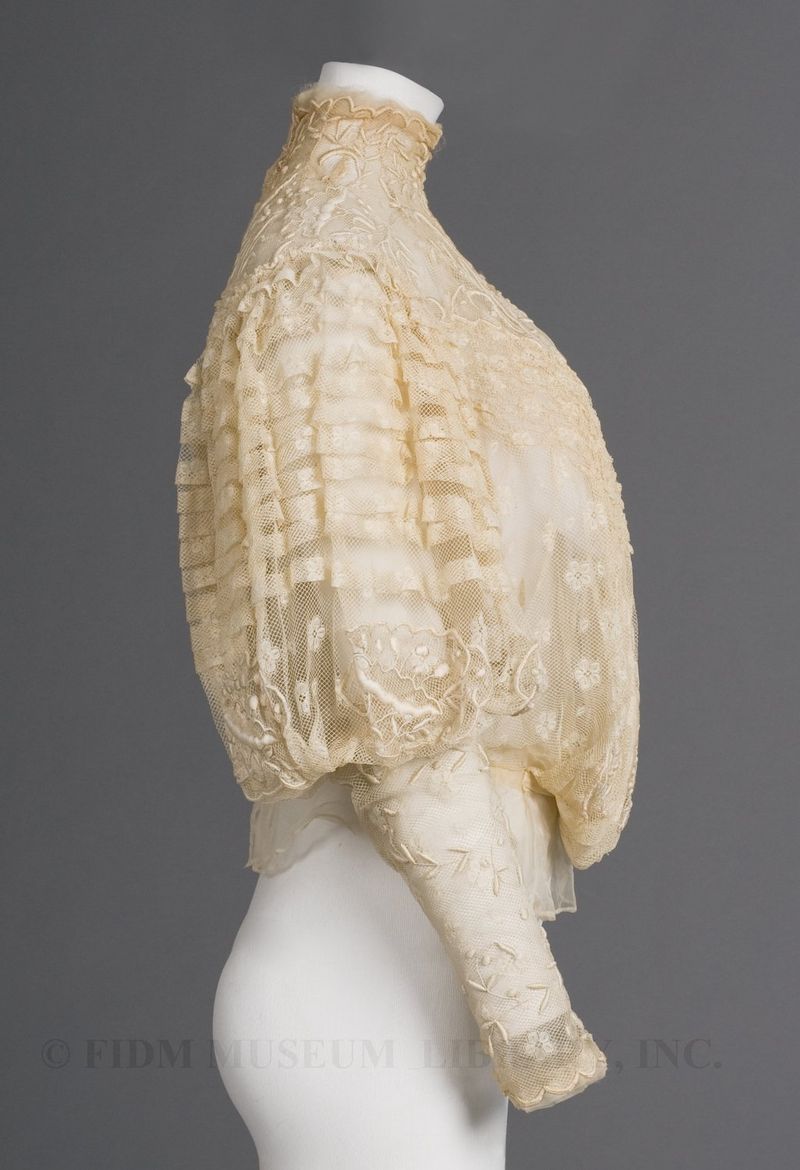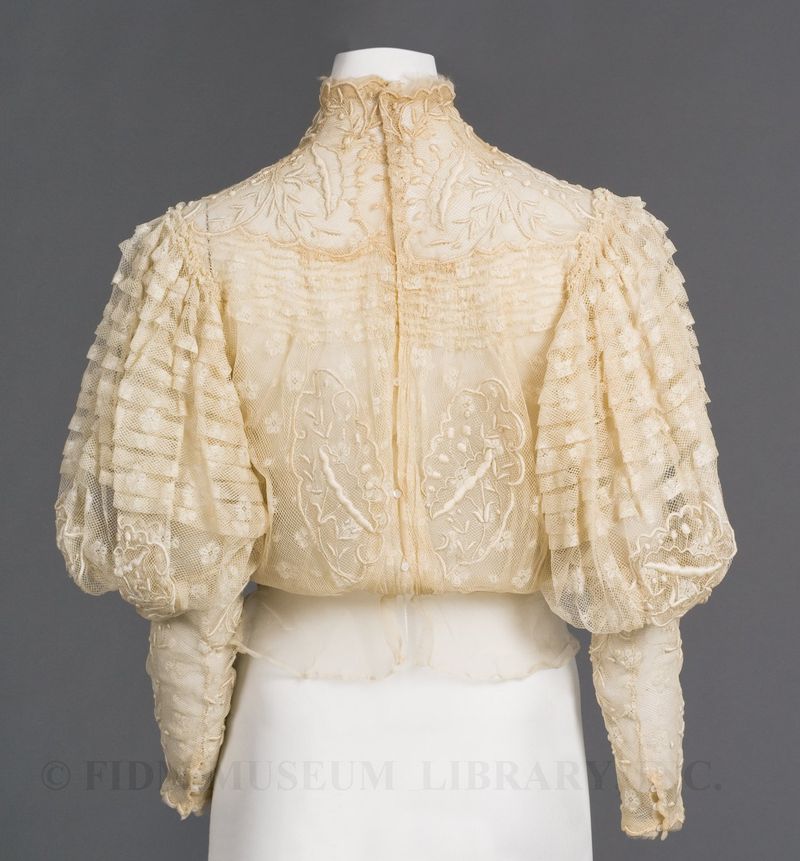Embroidered bodice, c. 1905
 Bodice
Bodice
Silk net with embroidery
Gift of Deane Funk
87.286.1
Made from ivory silk net embroidered with an allover floral pattern, this elegant bodice gives the impression of being completely sheer. Actually, the bodice is lined with a layer of ivory silk, thus preserving the modesty of the wearer. Though the bodice itself is made from a fragile, insubstantial textile, it was worn over a rigid foundation: the S-bend corset. This corset, with its flat front and steel busk, forced the hips back and the bust forward into a distinctive S-shape. The resulting silhouette idealized the body of a mature woman, featuring a full monobosom, tightly cinched waist, and full, rounded hips. This silhouette dominated women's fashion from 1900 until about 1908, when it was gradually replaced by the unarticulated, upright lines of the empire silhouette.
In the photo below, note how the front of the bodice was created to allow for a generous monobosom. Excess fabric drapes slightly over the waist of the bodice. When worn, the shape of the bodice would fill out, becoming rounder at the bust. To achieve the desired silhouette, many women resorted to padded bust improvers. This type of bust was sometimes called the pouter pigeon, as it resembled the full, puffed chest of a pouter pigeon.
During the first decade of the 20th century, fashionable dress favored soft, pale colors. Pale pinks, soft blues and a variety of white and off-white shades dominated women's dress. The popularity of soft colors may have been a reaction to the late 19th century craze for the bright, intense colors produced by synthetic aniline dyes. Compare the color of this two-tone purple c. 1872 day dress to the soft color of the bodice pictured here.
Transparency was another important theme, and many women's garments from this period feature sheer layers of fabric accented with lace, embroidery or other trim. This c. 1903 raspberry pink day dress by Jacques Doucet features transparent layers and the same sleeve seen on our bodice. The leg o' mutton sleeve (full at the shoulders and tapered to the wrist) pictured here was popular, but shared the stage with other sleeves. Bishop sleeves and puffed sleeves restrained with ties or bows are also seen in garments from this decade.
This bodice was probably once part of a two-piece ensemble. Two-piece dresses were common, with bodice and skirt usually made from matching fabric. In an era when strict rules dictated appropriate dress for time of day and specific events, the high collar and long sleeves indicate when this bodice would have been worn. Ball gowns, the most formal level of dress, usually featured short sleeves and a revealing neckline. Dinner gowns usually featured a high neckline and elbow length sleeves. Day dresses were the most conservative, with high collars and wrist-length sleeves. Because of its high collar and long sleeves, we can make an educated guess that this bodice was once part of a two-piece day ensemble.
Though its highly unlikely we'll ever find the matching skirt, we do know where this bodice was made. A green and ivory label inside the bodice reads: Mmes Aubrejeac & F. Bonnesseur, 113. Rue Réaumur, PARIS. Early 20th century Paris was home to the most famous garment makers in the world. American women who could afford the journey travelled to Paris one or two times per year to refresh their wardrobes. Women who couldn't afford the trip to Europe depended on local shops to import a selection of Parisian garments for sale or reproduction. This system allowed women of varying incomes access to the latest fashions. Though we don't know who purchased this bodice, we can assume that the wearer was a woman with the means and interest to obtain high-quality fashion direct from Paris.
The makers are also a bit of mystery. Initial research uncovered almost no information about Mmes Aubrejeac & F. Bonnesseur. If you are familiar with these names, send us a message. We'd love to find out more about this Parisian duo and see other examples of their work.

